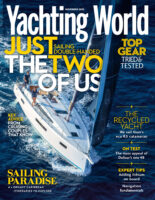Dutch marque Vaan is creating markedly different catamarans built from up to 70% recycled aluminium. Toby Hodges took the new 50ft Vaan R5 for a test sail to see what it's all about
Vaan R5 review: The 50ft electric multihull pushing sustainable sailing
Vaan is an emerging Dutch brand creating a new generation of markedly different catamarans. Travel 20 miles from the historic city centre of Rotterdam, on through Europe’s largest commercial port, and you’ll reach the peaceful little town of Hellevoetsluis where Vaan is based. Founded in 2018 by Igor Kluin and Nienke Van Klooster, the company is located on the banks of the Haringvliet, an inland basin separated from the North Sea by a lock.
The site offers ideal enclosed waters for testing, but above all a space for long-term development – Vaan has already reserved a large part of the technical area of the marina, and a brand-new building is ready to accommodate up to three boats under construction at the same time. Moored at the pontoon, the Vaan R5 looks just as striking as it did in the computer-generated images that caught our attention.
Although the freeboard is high (2.12m/7ft 11in), it’s the smooth design with very few rough edges that makes the biggest impression. As raw aluminium is unforgiving of any flaws, we were pleasantly surprised by the fluidity of the hull’s lines, with no visible deformations.
Better still, the material used incorporates up to 70% recycled aluminium – made from things like window frames, number plates and road signs. Once crushed and sorted, they’re combined with 30% pure aluminium alloy and 0.5% additives, such as argon, to achieve the required marine quality standard 5083. In terms of CO2 emissions, the figures are significant, as its production emits only 2kg of CO2 per kilo of aluminium, seven times less than conventional material, according to Kluin.
To optimise weight, the thickness varies depending on the area: the hulls are 7mm thick, the areas around the keel are 10mm and the deck is 6mm thick. The structural frames are very tight, as can be seen in the very large sail lockers, located in the two bows, and the mast foot lockers, which are also generously sized. A big benefit this rigid construction brings is that Vaan catamarans can have single-piece glass deckhouse windows, offering almost unobstructed surround views. Here, on the 49ft R5, they’re double-glazed, while the older 42ft R4 has a single layer of glass.
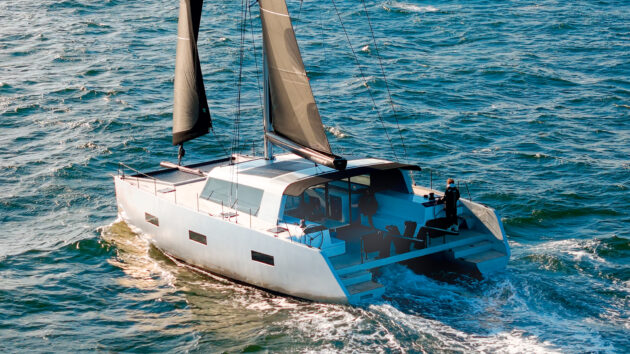
Premium fast cruising. The R5 has high freeboard, but coachroof and boom are kept low, maximising sail area. Photo: Vaan Yachts
Sailing Smarter
Ecology is one of the three strategic priorities behind the creation of Vaan catamarans. Their life cycle assessment has been studied in detail, right up to their final recycling. But in addition to their highly distinctive style, the third major criterion that influences all designers’ choices is performance under sail.
For Kluin, who started sailing at the age of three, a yacht must perform well, whatever the wind conditions. This is non-negotiable. So, while Vaan means ‘wind vane’ in Dutch, it is also an expression that could be translated as ‘go where the wind blows’.
Anyone surprised that aluminium is associated with performance may be forgetting its excellent weight-to-rigidity ratio. Until the rise of composites, particularly carbon, it was used for a long time in ocean racing. Among the most famous examples are Flyer, winner of the second Whitbread Round the World Race in 1977/78, and the 12-Metre JI boats built for the America’s Cup, which were made of aluminium until 1987. During the same period, French sailors Eric Tabarly (Paul Ricard), Olivier de Kersauzon (Kriter) and Marc Pajot (Elf Aquitaine, winner of the 1982 Route du Rhum) made it the core material of their offshore racing multihulls.
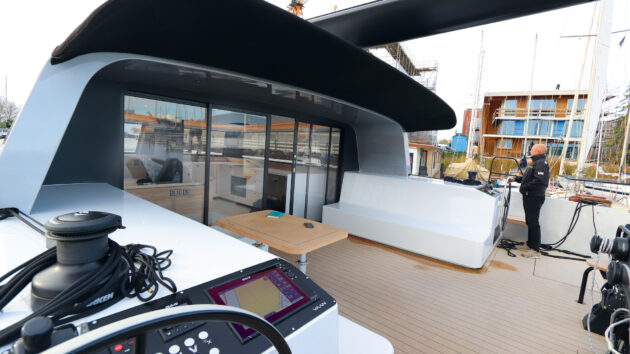
The very beamy cockpit can be covered with a partial fabric bimini or full hard top. Photo: Vaan Yachts
However, before checking whether the 125m2 of upwind sail area is enough to help this 18-tonne craft sparkle under sail, we leave the port… in silence. As on the first three Vaan catamarans already built, this second R5 is powered solely by electricity. Energy storage is provided by a bank of LFP (Lithium Iron Phosphate batteries).
Admittedly, they have a slightly lower energy density (-14%) than conventional lithium-ion batteries, but on a 15m catamaran this is not much of a problem. In addition to their slightly lower cost, they offer greater longevity as they can withstand many more complete charge-discharge cycles. The figure of 5,000 cycles (instead of 1,000) before falling to 80% of their initial capacity is mentioned. They also present much less risk of fire.
Finally, a key element in Vaan Yachts’ strategy, is that they’re less polluting and can be stored for long periods. According to the manufacturer, with 60kW of batteries on board, fixed here in the central crossbeam, the Vaan R5 can motor for four to five hours, depending on conditions, at a cruising speed of between five and six knots.
For a catamaran which promises performance under sail, even in light winds, this should cover nearly 90% of engine use. On a performance catamaran, engine use is mostly limited to entering and leaving port, or when anchoring and raising the anchor. Beyond that, if all green energy sources are exhausted and the wind has died, a 15kW backup generator is installed on board.
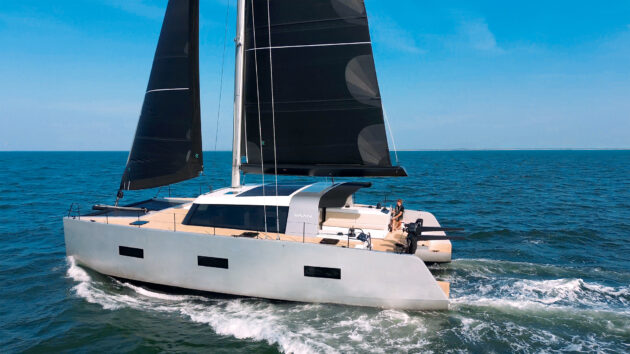
Visibility to both bows is maintained thanks to the huge glass windows. Photo: Vaan Yachts
This is the right power for engines that will require 7.5kW each to bring the R5 up to cruising speed. The generator can be seen as a safety feature, but also as a means of extending the boat’s range, allowing it to sail under engine power for around four days. The pod engines installed during our test were prototypes and will be replaced by production models for delivery to the end customer.
For reasons of confidentiality we can’t go into detail about the installation, but from what we’ve seen it looks very promising. To improve hydrodynamics, the pods will retract into the hulls when the boat is under sail. And for better manoeuvrability in ports, the pods are also steerable – we weren’t able to test these two features during our trip as they were still in the testing phase.
Quiet Departure
The cruising speed under engine (5.6 knots) was confirmed as soon as we left the harbour. Hoisting the mainsail is done with the touch of a finger from the helm, thanks to the impressive Furlerboom. I’d never been very convinced by furling booms on multihulls of this size, but the efficiency of this surprised me. The composite casing is wide around the furling profile, leaving plenty of room for the sail.

Wide, clear side decks. Photo: Vaan Yachts
The sail, designed by Quantum, is very well cut, and the flexible luff connecting it to the mast, a critical point on this type of system, is particularly well adjusted in its lower section. To maximise the sail area and lower the centre of gravity, the gooseneck has been lowered as much as possible and the boom skims the deckhouse.
The self-tacking jib Solent unfurls just as easily, and we begin our journey north-west. In these sheltered waters the sea is calm and with 0.83m of clearance under the bridgedeck, there is little chance of any waves slapping beneath. The wind during our trial is irregular, and many obstacles (buoys, shipping traffic, banks, etc), present frequent reasons to tack.
These are all opportunities to see that the Vaan R5 is competent at this exercise. It barely slows down while tacking and offers a close-hauled angle near to the holy grail of 90°. On a reach and then downwind, without a headsail larger than the Solent, we cannot say for sure whether the R5 would meet or exceed the 10 knots given on the polar curves calculated by Dykstra, but the responsiveness of this multihull to the slightest breath of wind makes me optimistic.
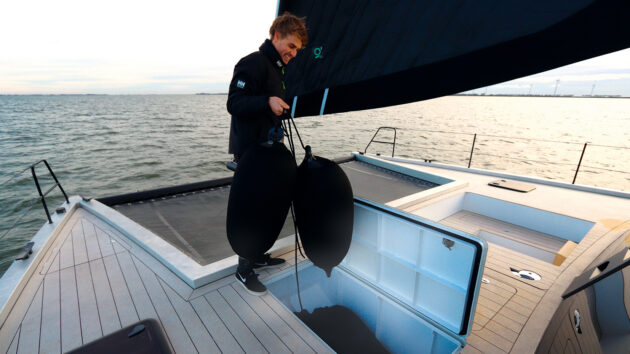
Plenty of deck stowage on the R5. Photo: Vaan Yachts
Upwind and downwind, steering is a pleasure because visibility is always ideal – whether looking to the sails, the bow in front of the helmsman, or even the opposite bow (thanks to the large glass surfaces of the deckhouse). The steering system supplied by Jefa is really precise. It offers no play, to the point that the wheel may feel a little stiff in light winds, but the advantage is that it allows you to maintain control without any effort when the breeze picks up.
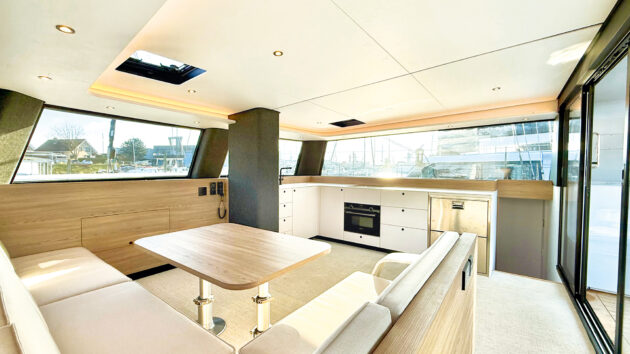
Vaan promotes luxury living with a minimalist, architectural style. Photo: Vaan Yachts
Bold Interior Design
As the afternoon draws to a close and the outside temperature drops significantly on the North Sea coast, we take the opportunity to explore the interior. Once the large sliding glass door is closed, the atmosphere immediately becomes warmer. The fittings, described as minimalist
by Kluin, take the concept of simplicity even further than the competition in this sector.
There’s something reminiscent of Apple or Tesla minimalism about the interior. So, you’ll either love it or hate it, but no-one will be indifferent, that’s for sure. Apart from a few minor details – the absence of fiddles on the kitchen worktop and the highly symbolic folding chart table – I really liked it.
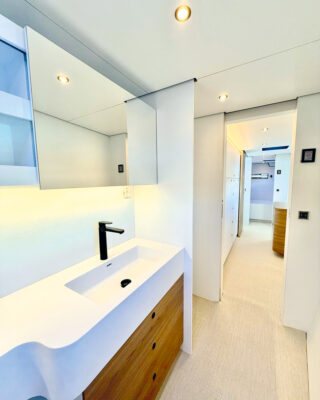
Photo: Vaan Yachts
Neat and distinguished at the same time, the main saloon and living area deserve much praise. The view to the outside is perfect, whether from the galley with its ample stowage space, or from the saloon, which is tastefully positioned facing forward. All the materials are high quality, with the occasional welcome touch of originality, such as the graphite grey felt covering the mast step. An example of detail is to be found in the bench armrest, which successfully marries shapes and materials, including metal, wood and fabric.
The hull steps are undoubtedly designed to Northern European standards and seem a little steep for my 1.73m height. However, the 2.09m headroom once in the hulls really helps contribute to the impression of space. The aft berth is integrated into the structure, providing rigidity without adding weight, as is the case on performance composite multihulls. On the port side, a huge dressing room occupies the central part of the hull, leading to an equally impressive washroom.
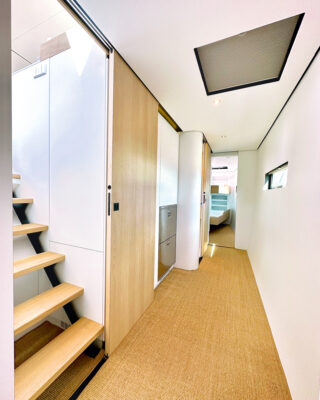
‘Living areas are tasteful, neat and distinguished’. Photo: Vaan Yachts
On the starboard side, the forward cabin has two bunk beds, as requested by the owner. A shared bathroom is located in the passageway on the inner side of the hull. There are 600lt tanks integrated under the floors of each hull: one for water, one for diesel for the generator. The Vaan is thermally and acoustically insulated with cork, a material which serves both the ecological and lightweight ambitions of the brand.
The interior temperature is regulated by a reversible air conditioning system that operates on the principle of a heat pump, which is very energy efficient. Its coefficient of performance (CoP) of six means that for every kW of electricity consumed, it produces 6kWh of thermal energy (heat or cold). Kluin assures us that even in the Mediterranean in summer, the interior can be cooled using only the 1,800W of solar panels installed on the deckhouse.
Vaan R5 specifications
LOA: 14.95m 49ft 3in
Beam: 7.94m 26ft 3in
Displacement: 18,000kg 39,683lb
Sail area (upwind): 125m² 1,345ft²
Sail area (downwind): 250m² 2,690ft²
Mainsail: 82m² 883ft²
Self-tacking jib: 45m² 484ft²
Gennaker: 172m² 1,851ft²
Code 0: 120m² 1,292 ft²
Engine: 2×7.5kW electric pods
Battery bank: 60kW
Generator: 15kW
Fuel tank: 600lt 132gal
Water tank: 600lt 132gal
Price: ex VAT €1,496,750 (test boat) €1,900,000
 If you enjoyed this….
If you enjoyed this….
Yachting World is the world’s leading magazine for bluewater cruisers and offshore sailors. Every month we have inspirational adventures and practical features to help you realise your sailing dreams.Build your knowledge with a subscription delivered to your door. See our latest offers and save at least 30% off the cover price.
Note: We may earn a commission when you buy through links on our site, at no extra cost to you. This doesn’t affect our editorial independence.
Verdict
The Vaan R5 is not like other 50ft multihulls. It embodies a new approach to cruising that is more sustainable and quieter, but without compromising on performance or luxury. Recycled aluminium, electric propulsion and a bold design are all strong choices. Taken together, they paint a different picture from other offerings on the market, and it comes as little surprise that the Vaan range could soon be expanded with an R8. There’s little doubt that the R5 will be well-received by those who want to sail differently, with a reduced environmental impact from construction to use, but with style and good performance under sail.

